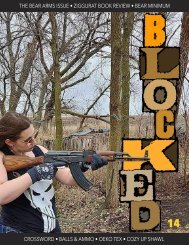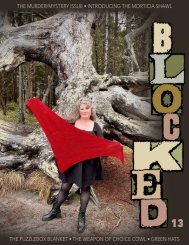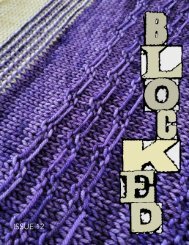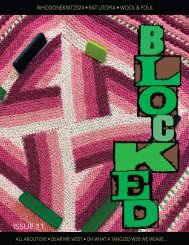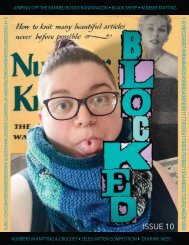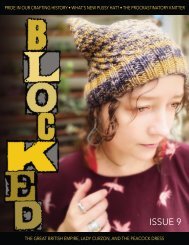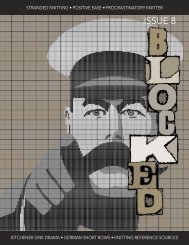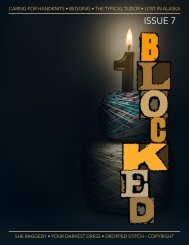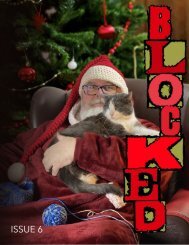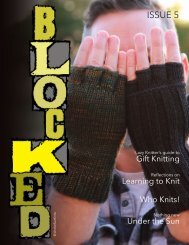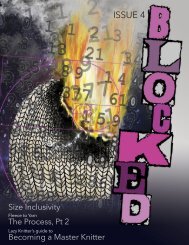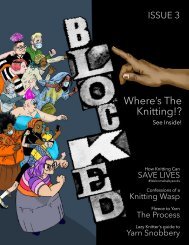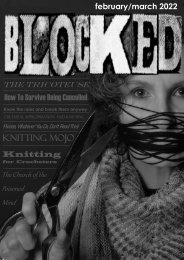You also want an ePaper? Increase the reach of your titles
YUMPU automatically turns print PDFs into web optimized ePapers that Google loves.
A STITCH IN THE SKY • THE GOOD, THE BAD, AND THE UGLY CATS SHAWL • SHARK WEEK 2024<br />
KNIT YOUR BIT • THE ZIGGY SHAWL REVIEW • KNITTING FICTION • THE COTTON FAMINE
TEAM <strong>BLOCKED</strong><br />
Editor in Chief<br />
Neil James<br />
For all enquiries:<br />
blockedmagazine@gmx.com<br />
Layouts, Graphics, and Ads<br />
BS Designs<br />
Copy Editor<br />
Cézanne Pellett<br />
Unless otherwise indicated the information, articles, artwork,<br />
patterns and photography published in <strong>BLOCKED</strong> Magazine<br />
are subject to copyright ©2024 <strong>BLOCKED</strong> Magazine.<br />
Editorial Assistants<br />
All rights reserved.<br />
Cover Model<br />
Denise Pettus, Karen Juliano, and Annie Robinson<br />
Laura Neubauer<br />
Tech Editors<br />
Cézanne Pellett and Annie Robinson<br />
Cover Photography<br />
Emseepixels<br />
www.instagram.com/emseepop/<br />
emseepixels.co.uk/<br />
www.youtube.com/@emseepop5042<br />
Content Writers<br />
Amy D, Cézanne Pellett, Jo-Bob,<br />
Katie Gerwein, Anne Pinkava, and<br />
Uknitted Kingdom<br />
Pattern Designers<br />
Mockingbirdsrealm,<br />
Uknitted Kingdom
Dear Readers,<br />
Since the last issue, I overcame my<br />
dislike of driving farther than one hour in<br />
any direction and, like Shackleton,<br />
bravely ventured over moor and dale<br />
into deepest darkest Teesside to visit<br />
Annie in Hartlepool.<br />
Annie (a Stitch in the Sky) is the<br />
super-model on this issue’s cover.<br />
Sporting her mohair Ugly Cats Cape,<br />
she posed and leaped along Hartlepool<br />
beach whilst her talented daughter,<br />
Emily, took photos. I didn’t actually need<br />
to be there, but I wanted to see and<br />
touch this magnificent shawl/cape in<br />
person.<br />
It was a fabulous weekend. The<br />
weather was flawless. The hottest weekend ever (if you believe the<br />
Climate Change Cult) with a sea breeze just perfect for those “wind<br />
tunnel” tousled hair shots.<br />
Annie’s dogs, Lottie and Roxy, were equally as adept at<br />
super-modeling and, I’m sure, behind the scenes, there was<br />
some professional jealousy between them.<br />
It was difficult to choose which photos to feature as they were all<br />
so good. Those we haven’t used this issue will probably appear on<br />
Instagram or on a YouTube episode at some point in the near future.<br />
We’ve left out the dishidents from this issue (and probably the<br />
next issue too) as we want the dishident number to match the<br />
magazine issue number. They will return with issue 17.<br />
The cross-stitch patterns I’ve designed for this issue are two of a<br />
set. The designs have been a top-secret project that only Cézanne<br />
and Therese of KnitNite have known about. This issue is apt to release the first two as the full set<br />
depict the knitting heroes of Blocked and the theme of this issue is “Heroes.” The other cross<br />
stitch will be released in future issues. Enjoy!<br />
Neil<br />
Editor-in-Chief<br />
3
y Jo Bob – Commentator, Knit Nite Podcast<br />
Pattern Review:<br />
THE ZIGGY SHAWL<br />
by Joji Locatelli<br />
Her husband later joined<br />
her in another dyeing endeavor,<br />
producing roving<br />
dyed in bright colors, while<br />
Joji began dabbling in publishing<br />
knitwear designs. Her<br />
first published pattern on<br />
Ravelry was the Garter Stitch<br />
Baby Cardigan in 2008. This<br />
cute little boxy crossover cardigan<br />
with two buttons is designed<br />
in 4 ply fingering yarn.<br />
In February 2016, I first heard of Joji Locatelli during<br />
Episode 2 of The Grocery Girls Podcast. They showcased<br />
her 3 Color Cashmere Cowl (published on Ravelry<br />
in 20<strong>15</strong>). I've since obtained the pattern, and allocated<br />
yarn, but am yet to knit it.<br />
In October 2016, on the Fruity Knitting Podcast, Andrea<br />
interviewed Joji, describing her as a “Gorgeous mixture of<br />
intelligence and style, and elegance, and humility.” During<br />
the interview, Joji displayed some of her garments<br />
and I liked her minimalist style with feminine detail.<br />
Hailing from Buenos Aires, Argentina, Joji spent years<br />
studying medicine and graduated from university in 2003<br />
to begin her internship as a doctor. She soon realized that<br />
she didn't enjoy working as a doctor and tried her hand as<br />
a knitting teacher and a yarn dyer of bright, colorful<br />
skeins. The skeins were sold at her favorite yarn store<br />
where she eventually secured a position on staff for four<br />
years.<br />
In August 2012, the Boxy<br />
Sweater (inspired by a storebought<br />
fashion sweater), with its wide body and skinny<br />
sleeved design, knit in Madelinetosh Tosh Merino Light,<br />
became a huge success with knitters worldwide. It is possibly<br />
the most popular sweater designed by Joji and she<br />
has developed many new design iterations inspired from<br />
the original Boxy Sweater.<br />
The Hipster shawl was published in January 2018 and<br />
gathered a following of shawl knitters showing their projects<br />
on podcasts that I viewed.<br />
I began following Joji’s podcast on YouTube of Knitting<br />
Journals debuting in February 2018. I especially enjoy the<br />
podcasts when Joji’s mom, Virginia, joins her. Their<br />
mother/daughter relationship is full of warmth and laughter.<br />
It is impressive that Joji openly shares her working<br />
processes and progress of new knitwear ideas and test<br />
knits; with honest opinions of the yarns used.<br />
4<br />
Continued on next page...
Ziggy Continued...<br />
In 2019, Joji published Odyssey, a free shawl knit pattern.<br />
I made and gifted one to a friend who adored the<br />
shawl which encouraged me to purchase and make<br />
more Joji Locatelli designs.<br />
The Washed Out Shawl is an asymmetrical shawl with<br />
a super long tapered cast on end, which I really disliked<br />
so I gifted it. I also gifted the Storm Shawl. The Party on<br />
my Needles Shawl was super pretty, knit in mini skeins<br />
of contrast colors, and difficult to part with, but again, it<br />
was gifted. The Super Simple Summer Sweater was<br />
another successful knit that I gifted to a friend in Japan<br />
who loves it.<br />
For this issue, I dug out another Joji shawl pattern I<br />
purchased in 2019 but had yet to knit for myself. The<br />
Ziggy Shawl was published in a neutral-colored yarn as<br />
a single-color shawl and I decided to color it up. For my<br />
version, I've used one ball of the Australian yarn company<br />
White Gum Wool’s 4-ply fingering, 100% Ethical<br />
Superfine Merino in the color Sedge for the lace sections.<br />
I used 2 balls of the French created, Belgian<br />
made, Plassard Algasoie Imprimée (Plassard’s Printed<br />
Seaweed), 70% Alpaca/30% Silk Lace in Color no. 64 for<br />
the garter stitch sections. I used lace yarn single<br />
stranded even though the pattern calls for 4-ply fingering<br />
weight yarn. As described, this pattern design is<br />
very simple to make with alternating bands of lace and<br />
garter stitch. It is a two-skein shawl knit on US size 6<br />
(4mm) needles.<br />
The directions are very well written, with a chart option<br />
for the lace, glossary explanations, a YouTube link<br />
for clarity, and abbreviations. There is a stitch count<br />
tally for the set-up section, the first and second lace<br />
sections, and the first garter band. The lace pattern is<br />
easily memoizable across the row after the first few repeats<br />
and the garter stitch bands are mindless and possibly<br />
less enjoyable than the lace. The picot bind-off<br />
finishes the shawl with a simple, elegant edging.<br />
Joji currently has 327 designs published on Ravelry.<br />
Some of her designs are free digital downloads. She<br />
designs pullovers and tunics, shawls and wraps, cardigans,<br />
socks, cowls, and hats. You also can find her patterns<br />
on her website, www.jojiknits.com.<br />
Joji is also published in 30 books and magazines, including<br />
her decade long collaboration with Finnish designer<br />
Veera Välimäki, with their Interpretations<br />
Collections. You can access some of the older printed<br />
versions and newer digital publications at<br />
www.jojiandveera.com.<br />
Each year Joji hosts a fall knitalong. Thousands of<br />
knitters from all over the world get together to join this<br />
free event.<br />
Joji & Co. is another collaborative project of Joji<br />
and her fellow Argentine Artisan friends, producing<br />
handmade accessories of leather, yarn, and jewelry<br />
(www.jojiandco.com). How I wish Santa would bring me<br />
a leather project bag from Joji!<br />
You can learn more about Joji Locatelli and her knitting<br />
journey from her Keynote Address for Vogue Knitting<br />
Live 2023, “The Story of a Knitter,” on YouTube.<br />
https://youtu.be/LUaJ9c7iLt8?si=w0Q_L7S_DWwVT2j0<br />
Personally, I am a fan of Joji’s style of pattern writing<br />
and her design projects. I agree with Andrea from Fruity<br />
Knitting; I think Joji Locatelli is a gorgeous mixture of<br />
intelligence, style, elegance, and humility.<br />
My next Joji knit has to be the 3 Color Cashmere<br />
Cowl that I coveted back in 2016. I think it's still a timeless,<br />
simple, elegant design.<br />
My shawl wingspan ended up being six feet long<br />
without blocking so I did wash and simply shape the<br />
shawl for blocking the lace without stretching the shawl<br />
any larger. I think this shawl design lends itself to being<br />
knit in any gauge yarn and looks great in one colorway<br />
or many. Do you like my use of alpaca/silk lace for the<br />
garter section? I can tell you this Ziggy Shawl feels like<br />
it's floating upon my shoulders!<br />
5
6
SHARK<br />
WEEK<br />
2<br />
0<br />
2<br />
4<br />
Hello! Hello! Welcome to the second year of the<br />
PIK (Politically Incorrect Knitters) SHARK WEEK CHAL-<br />
LENGE! This year's theme is Raiders of the Lost Shark<br />
and runs from July 7th to the 14th.<br />
THE RULES ARE AS FOLLOWS:<br />
The Shark Week challenge is that you must begin<br />
and finish a project in the eight days of Shark Week,<br />
between July 7-14 (beginning and ending at midnight<br />
EST). If you don't finish in time, you have to RIP IT ALL<br />
OUT.<br />
Extra points are awarded for being on theme in<br />
project, yarn, bag, or by taking a picture of your project<br />
with something shark/adventure archaeology related<br />
in the background.<br />
You will have to take a picture of your finished project,<br />
or your ripped out yarn at the end of the week.<br />
Everyone, win or lose, is entered for prizes, and everybody<br />
gets Shark Week stickers, along with stickers<br />
of the logos of participating podcasts.<br />
The points system for prize entries is as follows:<br />
-3 points for any knit or crochet project<br />
-1 point for on theme project<br />
-1 point for on theme yarn<br />
-1 point for on theme bag or stitch markers<br />
-Up to 5 points for photos with Shark Week/Adventure<br />
Archeology items or shows in the background.<br />
--To enter, follow the Google form<br />
https://linktr.ee/Blockedmagazine<br />
For any questions, please email at:<br />
politicallyincorrectknitters@gmail.com<br />
-Thank you all for joining us, and thank you all for<br />
watching! Tune in for Shark Week Programing from our<br />
sponsors: Blocked Mag, Knit Nite, Shauna Stitches,<br />
Mystery Mouse Yarn, Texas Peach Knits, Wise Owl Knits,<br />
A Stitch in the Sky, Two Sisters and Some Yarn, Deprogrammed<br />
with Keri Smith, Carrow Brown, Mama Nevin.<br />
Thank you to all the affiliates and sponsors!<br />
7
POLITICALLY INCORRECT<br />
KNITTERS<br />
DESIGN SIZE<br />
60 stitches wide x 39 stitches high (approx. 3.75” x 2.44”)<br />
CROSS STITCH<br />
By Neil James<br />
MATERIALS<br />
14 Count Cross Stitch Fabric / Aida 94 x 55 stitches (approx. 5.75” x 4.44”)<br />
Cross Stitch needle<br />
Embroidery Hoop (optional)<br />
Scissors<br />
NOTES<br />
The stitches used throughout both pieces are typical full cross stitches.<br />
EXCEPT for sixteen x ¼ stitches (these are used for the eyes).<br />
Fig. 1 - Shows a typical full stitch on the left and a ½ stitch on the right<br />
(not actual colors in this pattern).<br />
Fig. 2 - Shows a typical full stitch on the left and ¼ stitches on the right<br />
(not actual colors in this pattern).<br />
Back-stitch sections:<br />
Fig. 3 - DK:<br />
For the eyebrows, nose, and mouth, use 2 strands of DMC 310 “Black”.<br />
Fig. 4 - Anne:<br />
For the glasses, nose, and mouth, use use 2 strands of DMC 310 “Black”.<br />
8
9
By Uknitted Kingdom<br />
THE GOOD, THE BAD,<br />
and The Ugly Cats Shawl<br />
During one such livestream, over a year after publication,<br />
the Ugly Cats Shawl became the topic of a heated<br />
conversation.<br />
10<br />
Longtime readers and viewers will know about my three<br />
beautifully ugly cats, Northstar, Inka, and Oli. The story of<br />
their lack of attractiveness has become legendary (in my<br />
mind anyway!).<br />
Gavriella Treminio aka @HelloGavriella, a particularly<br />
bland crafter with a penchant for online trolling, sent me a<br />
bizarre message, “All your cats are ugly.”<br />
Always one to turn insults against me into something<br />
useful, I named my first shawl design “The Ugly Cats<br />
Shawl.”<br />
Tabitha of Murderknits agreed to test knit the shawl but<br />
after knitting the first wedge or two, she said there was a<br />
problem. It was too big and was using much more yarn<br />
than the pattern stated. I went through the pattern instructions<br />
and could not find anything amiss. It ended up<br />
as a running joke and for quite some time, it was explained<br />
away as my being a super-tight knitter and Tabitha<br />
being an ultra-loose knitter.<br />
The shawl was published in Issue 5 of Blocked, and I was<br />
surprised it did not receive much feedback. Readers<br />
seemed to like it, but no one was knitting it. Time and<br />
tide wait for no knitter, so it became forgotten only to<br />
raise its ugly head occasionally during YouTube livestreams.<br />
Where I had used approximately 5g to 6g of yarn per<br />
wedge it became apparent others (who had started the<br />
shawl) had been using closer to 50g per wedge! I couldn’t<br />
understand it. I had bought a finite amount of yarn. I knew<br />
how much I had used. I had even knitted a hat from the<br />
leftovers of a 100g ball of black Opal sock yarn. All of us<br />
were arguing from a place of knowing we were right. I had<br />
only used that smaller amount of yarn and they had used<br />
much more yarn. But what was going wrong? It couldn’t<br />
be the gauge. My shawl was approximately 6/7 feet from<br />
wingtip to wingtip while Tabitha’s was on its way to being<br />
12 feet wide.<br />
This weighed heavily on me. I had a sleepless night or<br />
two. Again, I checked the pattern and couldn’t see any errors.<br />
I had written it in such a way that the knitter only ever<br />
had to count ten or 11 stitches at a time. How can these<br />
other knitters not know how to count to ten?<br />
Then, at 4 a.m. and in the middle of a stressful night’s<br />
“sleep” the answer came to me. It was so obvious. Too<br />
obvious. It was the stitch count. The pattern still worked; it<br />
was just too big.<br />
Of course it was the count. I got up and cast on the<br />
stitches. I did my usual trick of placing a marker every 50<br />
or 100 stitches. I probably put the needles down after<br />
casting on, and when I returned, I just assumed the<br />
markers denoted 100 stitches. I then counted 50 stitches<br />
as 100 stitches, twice! The cast on was 100 stitches too<br />
many. It all fell into place.<br />
By this time Annie aka @astitchinthesky had started the<br />
original, huge shawl. In mohair. I felt sick. I knew a mohair<br />
Continued on next page...
The Good, The Bad, Continued...<br />
a much more user-friendly manner. Where I once was writing,<br />
designing, drawing, proofing, and doing the layouts<br />
alone, we, the team, now share this between us.<br />
The updated pattern “The Ugly Cats Shawl v2.” (now in<br />
3 sizes) is included in this issue. Alongside the knitting<br />
pattern I’ve also written a Tunisian crochet version. The<br />
crochet version is smaller but can easily be made larger<br />
using a multiple of 10 +1 (101, 111, 121, 131, etc.).<br />
For the Tunisian crochet shawl, I decided to use some<br />
“problematic” yarn I had been gifted. The yarn was the<br />
Black Panther mini skein set from Adella of LolaBean Yarn<br />
Co. The yarn was dyed to represent characters from the<br />
Marvel movie, The Black Panther (originally created by<br />
Stan Lee and Jack Kirby).<br />
After purchasing the set, one of LolaBean Yarn Co’s customers<br />
was treated so badly by Adella that she did not<br />
want the yarn in her home a second longer. The yarn sat in<br />
a bag under my desk for about a year.<br />
I chose this yarn because I knew it was about the right<br />
amount of yarn for the shawl and, as the shawl was a prototype,<br />
I didn’t<br />
want to ruin yarn<br />
that I cared about<br />
if the pattern didn’t<br />
work.<br />
shawl of that size would be almost impossible to rip<br />
back. I offered to replace the yarn, but she was happy<br />
to continue. She wanted the biggest shawl in the<br />
world! Likewise, Tabitha decided to “spite knit” the<br />
larger size (don’t worry it’s all in fun!) probably to make<br />
me sweat as her considerable yarn stash shrinks visibly<br />
each livestream.<br />
I redrafted the pattern. Since first designing the shawl<br />
my pattern writing skills have improved significantly.<br />
Where once I tended to write Zimmermann-esque paragraphs,<br />
I now write more succinct pithy instructions. The<br />
welcome additions of Blocked tech editors (Cézanne and<br />
Annie) and a pattern reviewer (Jo-Bob) have definitely<br />
helped to tighten and structure the magazine’s patterns in<br />
In the packet<br />
the yarn looked<br />
very nice. However,<br />
when I<br />
opened the<br />
skeins, I could see<br />
half of the yarn<br />
set had resist<br />
marks where the<br />
ties were, and<br />
where the ties<br />
had been during the dyeing process. It was obviously not<br />
an intentional resist. It looked BAD. By the time I had crocheted<br />
three wedges of the shawl I had regrets in using<br />
the yarn. The undyed patches were visible.<br />
Rather than rip back, I chose to continue. Yes, the yarn<br />
would look terrible, but my design wouldn’t. I would use<br />
this as an opportunity to review LolaBean Yarn Co’s yarn in<br />
a way where I could present the evidence.<br />
Continued on next page...<br />
11
The Good, The Bad, Continued...<br />
As I continued, I noticed the yarn felt different to other<br />
hand dyed yarns. It didn’t have the luster or the plumpness<br />
I’m accustomed to. The black sections in particular, felt<br />
rough and wanted to grip to itself. I’m no expert but I believe<br />
this can be caused by either dyeing the yarn in scalding<br />
water, or by plunging the hot yarn into cold water to try<br />
The package arrived in a simple zip-bag made from a<br />
form of plastic leather (pleather?). There was a slight smell<br />
to the “pleather” but nothing unpleasant. Apart from one<br />
end of the zip, where it wasn’t sewn to close the opening, it<br />
appeared well constructed. Inside, the hooks were slotted<br />
into a sturdy, removable, piece of pleather. The hooks<br />
gleamed.<br />
Each hook is highly polished, smooth to the touch, light<br />
to hold, and has an indent for the thumb to rest whilst<br />
using. This latter feature is something I have never seen on<br />
a Tunisian hook before and I was worried (unnecessarily)<br />
that it would catch the yarn.<br />
The hook points and the hook lips are both extremely<br />
sharp – sharper than any hook I’ve used before. I love this<br />
about the hooks. For me, the sharper the needle/hook, the<br />
better. The hooks shepherded that yarn like a wise sheepdog<br />
herding ewes!<br />
to cool it down quickly rather than letting it cool slowly and<br />
naturally. I can’t say exactly how she did it, but Adella’s yarn<br />
was slightly felted.<br />
Adella has some nice ideas, some of the colors were<br />
nice... where she had actually covered the yarn. In places<br />
the reds and the purples were well saturated, but not at the<br />
resist points. Her blacks, although truly black, were felted.<br />
The cables (in three sizes) are sturdy and have no memory,<br />
so they don’t curl or bend. Where they attach to the hooks,<br />
they swivel. The benefit of this has become apparent after<br />
two weeks of regular use. Where other hooks/cables pull<br />
against me as I use them, these twist so there is no resistance<br />
to cause hand/wrist pain.<br />
Although the screw-in cable join is very tight and needs to<br />
be threaded carefully, it is so tight and smooth it is barely<br />
noticeable when in use. The stoppers for the end of the<br />
cord are made of metal. They’re of much higher quality<br />
In time, with more experience, Adella might become a<br />
reasonable dyer. Currently, I would say she needs to go<br />
back to the basics of yarn dyeing. Forget trying to be fancy<br />
and clever, focus on good, even coverage, and treat the<br />
yarn with more care. For the time being, at least, I would<br />
not recommend using LolaBean Yarn Co products.<br />
To make the shawl, I used some new Tunisian hooks<br />
bought after some reticence. Toni Lipsey of TL Yarn Crafts<br />
had recently reviewed an obscure set of hooks from Ali Express.<br />
She spoke very highly of them, so I put my distrust of<br />
sites like Temu and Ali Express to one side and ordered.<br />
The nickel-plated aluminum interchangeable Tunisian crochet<br />
hook set from QZLKNIT was £49.31 (inc VAT). I had a<br />
slightly anxious 3 week wait whilst they arrived from China<br />
(Yes! I know! But hooks!).<br />
12<br />
Continued on next page...
The Good, The Bad, Continued...<br />
than others I have used, such as Knitpro/Knitter’s Pride.<br />
There are some stitch markers that come in different<br />
shapes but those are not something I would consider<br />
when choosing hooks to buy. They do the job, what more<br />
can I say about them?<br />
My previous interchangeable Tunisian hooks have been<br />
the Knitpro/Knitter’s Pride Symphonie set and the Ginger<br />
set. In my view, these are great hooks, even if they’re almost<br />
indistinguishable in terms of use and feel. However,<br />
after using the QZLKNIT hooks, I have switched my allegiances.<br />
The QZLKNIT hooks are now my hook of choice.<br />
There is nothing I would change about them in terms of<br />
functionality. They’re fast, sleek, beautiful to look at, and<br />
a cut above anything I’ve used before. If you like your<br />
hooks sharp, then these might be for you.<br />
As with any other Tunisian set, the only thing missing is<br />
an attachment to join one hook to another for Tunisian<br />
crochet in the round. Although it’s simple enough to join<br />
two hooks via a cable, this isn’t the best option for small<br />
scale projects like mitts and hats.<br />
In an ideal world, the hooks would come in a folder<br />
more like the Ginger hooks, however, I prefer great hooks<br />
and an OK folder over a great folder and OK hooks.<br />
When I can afford it, I intend to buy a second set because<br />
I can’t bear to lose a hook and not be able to find a<br />
replacement. With the sets growing popularity the price<br />
might begin to rise. Get in before they sell out or become<br />
out of budget.<br />
*If you look closely you will see where LolaBeanYarnCo’s dye bled.<br />
THE PATTERN FOR THE TUNISIAN CROCHET VERSION OF THE SHAWL<br />
WILL BE AVAILABLE IN ISSUE 16.<br />
13
AN INTERVIEW WITH<br />
By Uknittedkingdom<br />
ANNIE FROM A STITCH IN THE SKY<br />
The front cover model for this issue is Annie of<br />
@stitchinthesky. She is modelling “The Ugly Cats<br />
Shawl,” designed by yours truly.<br />
Annie knitted the shawl in mohair which took her four<br />
months knitting monogamously! For the story behind<br />
the shawl see page 10, and the pattern is available on<br />
page 17.<br />
For those who haven’t met Annie on her own<br />
YouTube channel:<br />
https://www.youtube.com/@astitchinthesky4212<br />
or as a guest on KnitNite<br />
https://www.youtube.com/@knitnite<br />
I asked her some questions to help you get<br />
acquainted.<br />
Neil (N): Annie, tell us a little about yourself.<br />
Annie (A): I’m a self-employed seamstress living in the<br />
North East of England. I love my family, garden and to<br />
walk the dogs on our beach. I’m there every day and it<br />
almost feels like it’s mine. I’m always busy doing something<br />
but my house is still cosily slightly cluttered. My<br />
yarn and pattern stash is pretty extensive and I need to<br />
retire right now so I can make full use of it.<br />
N: Other than knitting, what crafts do you enjoy, and<br />
how long have you been practising the “woolly arts?”<br />
A: My favourite yarn is Berroco Andean Mist, a very<br />
soft lightweight, warm, luxury yarn. The fibres are suri<br />
alpaca and silk. My favourite pattern is Zweig by Caitlin<br />
Hunter. It’s an enjoyable knit with interest, style and<br />
wearability. I intend to make another. I don’t have any<br />
favourite needles. They must be circular and metal,<br />
wood or plastic depending on the yarn I’m using.<br />
Maybe I should try more. As for hooks, anything with a<br />
soft grip.<br />
N: On the cover you’re wearing a T-shirt with a slogan.<br />
What can you tell us about that?<br />
A: The dictionary definition of woman should not<br />
offend anyone. Unfortunately, some people don’t agree.<br />
Kellie J. Keen first used this as a billboard near the<br />
Labour Party conference in Liverpool. Her point was that<br />
woman is exclusive and doesn’t include men. Doctor<br />
Adrian Harrop from Newcastle was incensed by its<br />
presence as he believes it to be an insult to men who<br />
say they are women. The poster was removed but was a<br />
successful way to raise the issue resulting in a hilarious<br />
TV spat between the two.<br />
N: The theme of this issue is “Heroes.” Do you have a<br />
knitting hero and/or anyone you consider a hero? Why?<br />
A: I enjoy spinning on my Ashford joy but don’t spend<br />
enough time doing so. Every now and then I feel I’d<br />
rather crochet, especially if I’m wanting to make a blanket.<br />
I love sewing but rarely sew for myself. I like patchwork<br />
quilting, colour combinations are endlessly<br />
pleasing to create. My fabric stash is inspirationally<br />
large. It must be around 50 years since I learned to knit/<br />
crochet. I used those skills during my college and uni<br />
years, and when I gave up smoking at 24 made sure to<br />
keep my hands busy with knitting projects.<br />
N: Please tell us: Your favourite yarn, your favourite<br />
pattern, you favourite needles/hook, and share why if<br />
you can.<br />
14<br />
Continued on next page...
Interview with Annie Continued...<br />
A: My knitting hero is definitely my nanny. She was my<br />
father’s mother and insisted on being the one to teach<br />
me how to knit and crochet. Elsie had endless patience<br />
when I went to stay with her and fixed every dropped<br />
stitch or mistake until I got the hang of it. Nanny was<br />
happy to knit matching Aran jumpers for the whole<br />
family. I remember her taking our measurements and<br />
knitting so quickly she clicked. Most of my family didn’t<br />
fully appreciate her talents. I still have some items she<br />
made, and she passed away around 30 years ago. I’ll be<br />
showing them on my YouTube channel at some point.<br />
There are a few people who I consider heroic today.<br />
People who speak the truth mostly, because so many<br />
others fail. Integrity is important to me.<br />
N: If you could have one superpower, what would it<br />
be, and why?<br />
A: I’d like to be able to cure people of cancer because<br />
it is unjust and indiscriminate. It sounds like a good<br />
idea, but the logistics would be a nightmare.<br />
N: After knitting The Ugly Cats Shawl, which new pattern<br />
has caught your eye?<br />
A: Nothing new yet, but I have a few items to finish. I<br />
may knit some of the Blocked Magazines dishidents as<br />
I’ve not made any of them yet. Can you tell me which is<br />
the rudest?<br />
N: What is your favourite yarny unpopular opinion.<br />
A: It’s ok to have a massive stash, lots of ufos, and<br />
some fibres that aren’t natural. Maybe my love of mohair<br />
lace is unpopular too.<br />
N: If money was no object what would your ideal crafting<br />
location be?<br />
A: Probably just my own garden with my pets. The<br />
money would mean I wouldn’t have to work and would<br />
get lots more knitting time.<br />
<strong>15</strong>
UGLY CATS SHAWL<br />
V2<br />
By Uknittedkingdom<br />
The Ugly Cats Shawl is a fingering-weight shawl pattern. Knit counterclockwise<br />
in a semi-circle, changing colors to create 3 claw motifs. The pattern’s title was<br />
inspired by an amusing Instagram insult, “All your cats are ugly!”<br />
YARN<br />
Small:<br />
MC approx. 400y/60g fingering weight neutral color<br />
CC approx. 880y/220g fingering weight in single contrasting<br />
color or approx. 9 x 25g minis<br />
Medium: MC approx. 580y/145g fingering weight neutral color<br />
CC approx. 1040y/260g fingering weight in single contrasting<br />
color or approx. 11 x 25g minis<br />
Large: MC approx. 920y/230g fingering weight neutral color<br />
CC approx. 2400y/300g lace weight in contrasting<br />
color or approx. 12 x 25g minis<br />
Sizes:<br />
Small (Medium, Large) 28” x 72”/71cm x 183cm (37” x 86”/94cm x 218cm, 46” x<br />
100”/117cm x 254cm)<br />
Gauge: 24 sts x 44 rows = 4” x 4”/10cm x 10cm<br />
Needles: US Size 2.5 (3 mm) or size needed to obtain gauge.<br />
SECTION 1<br />
I-cord<br />
In MC knit a 3-stitch I-cord of 191, (235, 290) rows.<br />
Row 1: Skip 1 st. With 3 stitches still on the needle PUK 176 (220, 275)<br />
Section 1 notes:<br />
Each wedge begins with a decrease at the outside edge and an increase (PUK) at<br />
the neck edge.<br />
Wedge 1 (Set up for Wedge 2)<br />
Continue in MC<br />
Row 2: GSR, k10, PM, k to last 3, sl3 wyif.<br />
Row 3: Knit to marker, turn to WS, RM.<br />
Row 4: GSR, k10, PM, k to last 3, sl3 wyif.<br />
Repeat rows 3 and 4 until there are no stitches left.<br />
Wedge 2<br />
Switch to CC.<br />
Row 1 (RS): K3, k2tog, k across to the end of row including each GSR “double<br />
stitch.”<br />
At the end of the row PUK 1 st from the I-cord tail.<br />
Row 2 (WS): GSR, k10, PM, knit to last 3 sts, sl3 wyif.<br />
Row 3: K to marker, RM, turn work.<br />
Row 4: GSR, k10, PM, knit to last 3 sts, sl3 wyif.<br />
Repeat rows 3 and 4, until you have no stitches left, ending with a WS row.<br />
Wedge 3<br />
Repeat Wedge 2 in CC.<br />
Continued on next page...<br />
17
Ugly Cat Shawl Continued...<br />
Wedge 4 Continue in CC.<br />
Row 1 (RS): K3, k2tog, k to end of row, including each GSR “double<br />
stitch.” At end of row, PUK 1 st from I-cord tail.<br />
Row 2 (WS): GSR, k10, PM, knit to last 3 sts, sl3 wyif.<br />
Row 3: K to marker. RM, turn work.<br />
Row 4: GSR, k10, PM, knit to last 3 sts, sl3 wyif.<br />
Repeat rows 3 and 4, knitting shorter rows each time until you have<br />
worked 6 GSR sections (not including the first one on the I-cord). Knit<br />
to end of row sl3 wyif.<br />
Next Row (RS): Switch to MC. K to marker. RM, turn work.<br />
Next Row (WS): GSR, k10, PM, knit to last 3 sts, sl3 wyif.<br />
Repeat rows 3, and 4, knitting shorter rows each time until you have<br />
no stitches left, ending with a WS row.<br />
Wedge 5 Repeat Wedge 2 in CC.<br />
Wedge 6<br />
Repeat Wedge 4 in CC changing to MC as instructed.<br />
Wedge 7 Repeat Wedge 2 in CC.<br />
Wedge 8<br />
Repeat Wedge 4 in CC changing to MC as instructed.<br />
Wedge 9 Repeat Wedge 2 in CC.<br />
Wedge 10 Repeat Wedge 2 in CC.<br />
SECTION 2<br />
Section 2 notes: Each wedge begins with a decrease at the outside<br />
edge but does not increase (PUK) at the neck edge.<br />
Wedge 11 Using MC<br />
Row 1 (RS): K3, k2tog, k across to the end of row including each GSR<br />
“double stitch.”<br />
Row 2 (WS): GSR, k10, PM, knit to last 3 sts, sl3 wyif.<br />
Row 3: K to marker, RM, turn work.<br />
Row 4: GSR, k10, PM, knit to last 3 sts, sl3 wyif.<br />
Repeat rows 3 and 4, until you have no stitches left, ending with a WS<br />
row.<br />
Wedge 12 Repeat Wedge 11 in CC.<br />
Wedge 13 Repeat Wedge 11 in CC.<br />
Wedge 14 Using CC<br />
Row 1 (RS): K3, k2tog, k to end of row, including each GSR “double<br />
stitch.”<br />
Row 2 (WS): GSR, k10, PM, knit to last 3 sts, sl3 wyif.<br />
Row 3: K to marker. RM, turn work.<br />
Row 4: GSR, k10, PM, knit to last 3 sts, sl3 wyif.<br />
Repeat rows 3 and 4, knitting shorter rows each time until you have<br />
worked 6 GSR sections (not including the first one on the I-cord). Knit<br />
to end of row sl3 wyif.<br />
18<br />
Continued on next page...
Ugly Cat Shawl Continued...<br />
Next Row (RS): Switch to MC. K to marker. RM, turn<br />
work.<br />
Next Row (WS): GSR, k10, PM, knit to last 3 sts, sl3 wyif.<br />
Repeat rows 3, and 4, knitting shorter rows each time<br />
until you have no stitches left, ending with a WS row.<br />
Wedge <strong>15</strong><br />
Repeat Wedge 11 in CC.<br />
Wedge 16<br />
Repeat Wedge 14 in CC, changing to MC as instructed.<br />
Middle Point<br />
Continuing in MC knit all the MC stitches, knitting the<br />
GSR double-stitches tbl as if each was 1 stitch. When<br />
you reach the last MC stitch, continue knitting until you<br />
reach the next CC double stitch. Turn. GSR, knit to last 3<br />
stitches, sl3 wyif.<br />
SECTION 3<br />
Notes: each wedge ends with an increase at the outside<br />
edge but does not increase (PUK) or decrease at the<br />
neck edge.<br />
Wedge 17<br />
Using MC<br />
Row 1: K3, k11, turn.<br />
Row 2: GSR, k to last 3 sts, sl3 wyif.<br />
Row 3: K to GSR double-stitch, k1tbl, k11, turn.<br />
Row 4: GSR, k to last 3 sts, sl3 wyif.<br />
Repeat rows 3 and 4 until the “spike” is the same height<br />
as all the spikes prior to the longer central spike. Knit<br />
back to the outer edge.<br />
Change to CC.<br />
Repeat rows 3 and 4 until you run out of stitches. Turn.<br />
K to last 3 sts, m1, sl3 wyif.<br />
Wedge 18<br />
Using CC<br />
Row 1: K3, k11, turn.<br />
Row 2: GSR, k to last 3 sts, sl3 wyif.<br />
Row 3: K to GSR double-stitch, k1tbl, k11, turn.<br />
Row 4: GSR, k to last 3 sts, sl3 wyif.<br />
Repeat rows 3 and 4 until you run out of stitches. Turn.<br />
K to last 3 sts, m1, sl3 wyif.<br />
Wedge 19<br />
Repeat Wedge 17 in MC, changing to CC as instructed.<br />
Wedge 20<br />
Repeat Wedge 18 in CC.<br />
Wedge 21<br />
Repeat Wedge 18 in CC.<br />
Wedge 22<br />
Repeat Wedge 18 in CC.<br />
SECTION 4<br />
Section 4 Notes: each wedge has an increase at the<br />
outside edge and a decrease (k2tog) at the neck edge.<br />
Wedge 23<br />
Using CC<br />
Row 1: K3, k2tog, k9, turn.<br />
Row 2: GSR, k to last 3 sts, sl3 wyif.<br />
Row 3: K to GSR double-stitch, k1tbl, k11, turn.<br />
Row 4: GSR, k to last 3 sts, sl3 wyif.<br />
Repeat rows 3 and 4 until you run out of stitches. Turn.<br />
K to last 3 sts, m1, sl3 wyif.<br />
Wedge 24<br />
Repeat Wedge 23 in CC.<br />
Wedge 25<br />
Using MC<br />
Row 1: K3, k2tog, k9, turn.<br />
Row 2: GSR, k to last 3 sts, sl3 wyif.<br />
Row 3: K to GSR double-stitch, k1tbl, k11, turn.<br />
Row 4: GSR, k to last 3 sts, sl3 wyif.<br />
Repeat rows 3 and 4 until the “spike” is the same height<br />
as all the spikes prior to the longer central spike. Knit<br />
back to the outer edge.<br />
Change to CC.<br />
Repeat rows 3 and 4 until you run out of stitches. Turn.<br />
K to last 3 sts, m1, sl3 wyif.<br />
Wedge 26<br />
Repeat Wedge 23 in CC.<br />
Wedge 27<br />
Repeat Wedge 25 in MC, switching to CC as instructed.<br />
Wedge 28<br />
Repeat Wedge 23 in CC.<br />
Wedge 29<br />
Repeat Wedge 25 in MC, switching to CC as instructed.<br />
Wedge 30<br />
Repeat Wedge 23 in CC.<br />
Wedge 31<br />
Repeat Wedge 23 in CC.<br />
Wedge 32<br />
Repeat Wedge 23 in CC.<br />
Continued on next page...<br />
19
Ugly Cat Shawl Continued...<br />
I-CORD BIND OFF<br />
Step 1: K3, sl 3 sts back to ln (this creates a corner).<br />
Step 2: K2, k2tbl, sl 3 stitches back onto the ln.<br />
Step 3: K2, k2tbl.<br />
Repeat Steps 1-3 until there are only 3 live sts on<br />
needle.<br />
Step 4: K2, sl last st onto rn. PU 1 st from garter st<br />
edge of Section 3.<br />
Step 5: Insert ln into backs of the PU’d st and sl’d st. K<br />
tog tbl.<br />
Step 6: Sl 3 sts back to ln and rep until there are no sts<br />
left to pick up.<br />
Step 7: Join two I-cord edges together using Kitchener’s<br />
stitch.<br />
Note: You may have to unravel some of the original I-<br />
cord before doing this to make join match.<br />
Weave in any remaining ends, wash and block.<br />
ABBREVIATIONS<br />
GSR (German Short Row): Pull up on working yarn<br />
to create a “double stitch.” For a good tutorial, visit<br />
Nimble Needles.<br />
https://youtu.be/i_F8A5Lyz88?si=7xFq4mqGkTwNqid9<br />
k: Knit.<br />
k2tog: Knit 2 together.<br />
ln: Left needle<br />
m1 (Make 1): Pick up bar between stitches from front<br />
to back then knit bar tbl.<br />
PM: Place marker.<br />
PU(‘d): Pick up/Picked up<br />
PUK: Pick up and knit<br />
rep: Repeat<br />
RM: Remove marker<br />
rn: Right needle<br />
RS: Right Side.<br />
Sl(‘d): Slip/Slipped<br />
tbl: Knit through back loop.<br />
tog: Together<br />
WS: Wrong Side.<br />
wyif: With yarn in front.<br />
20
Down<br />
1. Everyman hero of the book The Hobbit, who leaves his common life<br />
to go on an adventure that turns him into a hero who does many great<br />
things.<br />
2. A morally righteous hero in a work of fiction possessing superhuman<br />
abilities or supernatural powers who uses them to fight evil.<br />
3. often a girl’s first hero is her ______.<br />
4. Someone who has served in the armed forces.<br />
5. Bruce wayne’s superhero identity.<br />
7. The leading character, hero, or heroine of a drama or other literary<br />
work.<br />
12. widely considered to be the first comic book superhero, first appearing<br />
in 1936.<br />
13. A group of teenagers with attitude, who often wear colorful spandex<br />
and work as a team to overcome evil.<br />
14. “with enough _______, you can do without a reputation.” – Margaret<br />
Mitchell<br />
16. D-Day was the name given to the 6 June 1944 invasion of the<br />
beaches at ________ in northern France by troops from the Allied countries<br />
during world war II.<br />
18. A type of protagonist who lacks the traditional qualities associated<br />
with a hero, like courage, idealism, and an endless well of helpfulness.<br />
Typically have good intentions, but their methods may be unconventional<br />
and not in a good way.<br />
AcroSS<br />
6. In classical mythology, a person with preternatural courage and abilities,<br />
often the child of a god, and who achieves semi-divine status.<br />
8. A hero sandwich in new Jersey and Philadelphia.<br />
9. The highest and most prestigious decoration of the British honors<br />
system, awarded for valor “in the presence of the enemy” to members<br />
of the British Armed Forces and may be awarded posthumously.<br />
10. wwI soldier who started out as a conscientious objector but went<br />
on to become one of the most decorated US soldiers of the war, including<br />
the Medal of Honor.<br />
11. Secret identity of Superman.<br />
<strong>15</strong>. Historic funerary monument dedicated to deceased U.S. service<br />
members whose remains have not been identified, located in Arlington<br />
national cemetery in Virginia, United States.<br />
17. war memorial on whitehall in London, England, first unveiled in<br />
1920 which has since come to represent the commonwealth casualties<br />
from wwI, wwII, and subsequent conflicts.<br />
19. X-Men character with a genetic mutation called an X-Gene that<br />
causes their bodies to develop abilities that regular humans are unable<br />
to.<br />
20. The creator of Marvel comics and widely celebrated as a major icon<br />
in the world of comic books and superheroes.<br />
21
Book Review by Katie Gerwein<br />
Yarny Fiction<br />
BY DEBBIE MACOMBER,<br />
ANN HOOD, AND GIL MCNEIL<br />
Note: As a result of a suggestion from Tabitha of Murder<br />
Knits, Blocked is including book reviews of fiction books<br />
based on knitting.<br />
There are several authors writing contemporary fiction<br />
centered around knitters and yarn shops, including several<br />
murder mystery series. The following is a quick review<br />
of Debbie Macomber’s books and two fiction books I have<br />
enjoyed based on yarn stores, The Knitting Circle by Ann<br />
Hood and Needles and Pearls by Gil McNeil.<br />
Macomber is a prolific writer and has numerous fiction<br />
books, Christian literature books, and knitting pattern<br />
books published. Hallmark has produced a series of<br />
movies based on her Cedar Cove book series. I read<br />
some of her Blossom Street books, based around a yarn<br />
shop on Blossom Street, years ago. None of these books<br />
fall into what I would call lasting literature. They fall into<br />
what I call the “beach reading fiction” category. They are<br />
enjoyable, non-offensive, and quite predictable in terms<br />
of the characters and plots.<br />
Each character’s story is developed throughout the<br />
book. Without giving too much away, the book shows<br />
how a craft such as knitting, with repetitive muscle movement,<br />
can create the opportunity for our human brains to<br />
slow down. In slowing down, we can find some moments<br />
of sanity or, if not sanity, then hope. Also, the story demonstrates<br />
how community can be supportive during the<br />
worst times of our lives. While it is sad to recount the<br />
tragedies the characters experienced, the writing is good.<br />
I found the plot compelling, and I wanted to read each<br />
new chapter.<br />
The Knitting Circle was published by W.W. Norton &<br />
Company, in 2008. It is available via Amazon here. New<br />
and used hardback copies are selling from $1.99 to<br />
$11.62, some have shipping costs, others do not. Paperback<br />
new and used copies sell for $1.49 to $14.95, again,<br />
some have added shipping costs and others do not. The<br />
Kindle eBook sells for $9.99. It is available in audio<br />
through Audible for $10.89. All prices are current as of 19<br />
June 2024.<br />
22<br />
For this review, I re-read Ann Hood’s The Knitting Circle<br />
over the past two weeks, and now remember how well<br />
written the book is. It is a fictional account of Hood’s reallife<br />
tragedy and how being introduced to knitting and a<br />
circle of fellow knitters assisted her in processing through<br />
the grief emanating from her tragedy.<br />
Sadly, Hood lost a young child suddenly.<br />
Her novel traces the character,<br />
Mary’s, grief process in the time following<br />
the sudden death of her only<br />
child. Hood’s ability to express Mary’s<br />
grief is compelling and realistic. She<br />
includes other characters in the book<br />
who have experienced losses as well.<br />
The characters meet each other<br />
through a local knitting store at a<br />
weekly knit night.<br />
I have read three books by Ann Hood since 2019, all of<br />
which were terrific: The Obituary Writer, The Book That<br />
Matters Most, and The Italian Wife. I am predisposed to<br />
Hood’s writing style, her ability to develop characters, and<br />
tell a story in a compelling manner.<br />
If you don’t want to read about the<br />
grief of a mother losing her only precious<br />
child, I recently read another<br />
well written fiction, Needles and<br />
Pearls by Gil McNeil, based on a<br />
knitting shop and its current owner.<br />
This story follows the main character,<br />
Jo Mackenzie, the year after her husband<br />
dies. The main character relocated<br />
her two young boys from<br />
London to a small town to run her<br />
Continued on next page...
Book Review Continued...<br />
grandmother’s yarn shop. Jo juggles raising her boys, who<br />
have lost their father, an unexpected pregnancy, fitting into<br />
the local PTA (Parent Teachers Association), and earning a<br />
living from running a local yarn store. The story line evolves<br />
to include additional interesting characters and events.<br />
I found the book compelling, and I enjoyed the author’s<br />
writing style, the story line, and the characters. I recommend<br />
this book as well. While Jo is dealing with the<br />
death of her husband, the book remains humorous and<br />
does not delve into the depth of grief we saw in The Knitting<br />
Circle. I enjoyed this book enough that I likely will track<br />
down McNeil’s The Beach Street Knitting Society and Yarn<br />
Club that precedes the publication of Needles and Pearls.<br />
Needles and Pearls was published by Hachette Books, in<br />
2010. New and used hardback and paperback copies, as<br />
well as the eBook version, are available via Amazon here.<br />
Hardback copies range from $41.42 to $62.98; all also have<br />
a $3.99 shipping charge. Paperback copies range from<br />
$1.35 to $<strong>15</strong>.34, some have shipping costs, others do not.<br />
The Kindle eBook version is $8.63. All prices are current as<br />
of 19 June 2024.<br />
If you enjoy reading contemporary fiction and enjoy knitting,<br />
there are lots of available options. I encourage you to<br />
give Ann Hood’s The Knitting Circle a try and, for a lighter<br />
read, Gil McNeil’s Needles and Pearls a try. And if you are<br />
looking for light, beach reading, Debbie Macomber is<br />
another place to start. Wishing everyone enjoyable knitting<br />
and reading!<br />
23
24<br />
As we’re taking a dishident break for a couple of issues (to align the dishie number with the issue number)<br />
here’s the blank template for you to knit a plain dishie and/or for you to design your own. Send your dishie<br />
designs to blockedmagazine@gmail.com for a chance to see it in a future issue.
Podcasts!<br />
https://www.youtube.com/@TwoSistersAndSomeYarn<br />
https://www.youtube.com/@knitnite/featured<br />
https://www.youtube.com/@politicallyincorrectknitters<br />
SUBSCRIBE TO OUR<br />
CHANNEL!<br />
https://youtube.com/@blockedmagazine2859?si=-0u_JNUgDq7SHVcE<br />
25
A STITCH IN THE SKY By<br />
DESIGN SIZE<br />
42 stitches wide x 35 stitches high (approx. 2.75” x 2.31”)<br />
MATERIALS<br />
14 Count Cross Stitch Fabric (approx. 4.75” x 4.5”)<br />
Cross Stitch needle<br />
Embroidery Hoop (optional)<br />
Scissors<br />
NOTES<br />
The stitches used throughout both pieces are typical full cross<br />
stitches. EXCEPT for two x ½ stitches (these are used for outer<br />
corners of the glasses).<br />
Fig. 1: Shows a typical full stitch on the left and a ½ stitch on<br />
the right (not actual colors in this pattern).<br />
Back-stitch sections:<br />
Fig. 2: For the glasses, use 2 strands of DMC 208 “Very Dark<br />
Lavendar”.<br />
For the nose, use 2 strands of DMC 310 “Black”.<br />
For the mouth and lips, use 2 strands of DMC 349 “Dark Coral”.<br />
Neil James<br />
CROSS STITCH<br />
26
27
y Amy Dutsch<br />
KNIT YOUR BIT<br />
HOW CRAFTING HEROES HELP WAR HEROES<br />
Most people have heard the phrase “Knit Your Bit” at<br />
some point, especially anyone who’s been a fiber artist.<br />
“Knit Your Bit” (KYB) was an idea that originated in WWI 1 ,<br />
as a way to support our soldiers at war. According to the<br />
American Red Cross archives, “At the outset of World War<br />
I, Major Grayson M.P. Murphy, Red Cross commissioner to<br />
France, and the other U.S Army officers made an urgent<br />
appeal encouraging the homefront to knit mufflers, socks<br />
and wristlets for our soldiers and sailors.” 2 Women did not<br />
serve in the military at this time, so this was a way to serve<br />
their soldiers and country, and thus, “Knit Your Bit” was<br />
born. The tradition continued in WWII and still remains to<br />
this day, primarily through the Knit Your Bit program<br />
through the National WWII Museum.<br />
The National WWII Museum 3 is local to me, located in<br />
New Orleans, LA (USA) and is considered one of the top<br />
museums in the country. It was designated by Congress as<br />
the official WWII museum for the United States and is located<br />
on a six-acre campus in downtown New Orleans.<br />
The museum is regularly updating and expanding the<br />
campus. It is a beautiful museum, and if you ever have the<br />
opportunity to visit it, I would highly suggest that you do.<br />
Teachers and parents will find a plethora of information on<br />
the website to help educate children about WWII. One<br />
could easily spend days exploring everything the museum<br />
has to offer, including interactive 4-D experiences 4 , thousands<br />
of artifacts, a Victory Garden, dining at a soda shop<br />
that makes you feel like you stepped back in time, and<br />
BB’s Stage Door Canteen with events such as performances<br />
by the Victory Belles, a vocal trio who perform<br />
music from the 40’s, just like USO performers of the day. It<br />
truly is a remarkable museum with something for everyone.<br />
I have visited twice and wanted to visit again prior to<br />
writing this article but time and finances didn’t allow it.<br />
Those wanting to visit should know there are special times<br />
during the year when it’s less expensive for Louisiana residents,<br />
military and others. Keep an eye on their website<br />
for up-to-date information.<br />
The KYB program through the National WWII Museum<br />
was founded in 2006 and since its launch, has “reached<br />
more than 10,000 knitters and crocheters in all 50 states.<br />
Through their efforts, the Museum has distributed more<br />
than 50,000 scarves to veterans’ centers, hospitals, and<br />
service organizations across the country.”{sic}<br />
Various patterns can be found on the museum website,<br />
and there is a Facebook Group 5 , which has not been very<br />
active in recent years, but is still worth a visit if you are interested.<br />
Knitters and crocheters have always been known to help<br />
their fellow man, and many of us donate our finished<br />
items to a variety of causes. KYB is a wonderful testament<br />
to the power of crafters. Men, women, and children,<br />
joined together to knit and crochet (predominantly knit<br />
during WWI, due to the American Red Cross’ requirements)<br />
to create items for our soldiers. Today, people continue<br />
this tradition through a variety of programs<br />
including Hats for Sailors 6 , Operation Gratitude 7 , and<br />
more listed at the end of this article.<br />
It goes without saying that the men and women who<br />
serve their country both in war and times of peace, are<br />
true heroes. However, it’s not just the enlisted who pay the<br />
price for their service, and programs like KYB are a wonderful<br />
way for crafters to support the military, their families,<br />
and country.<br />
You may not be eating an MRE on the battlefield, or<br />
missing your child’s birth due to being deployed, but you<br />
too can be a yarn hero, and craft items with love and respect<br />
to support both active duty and veterans.<br />
So, perhaps today, it’s time for YOU to Knit YOUR Bit?<br />
Continued on next page...<br />
28<br />
1. https://www.theworldwar.org/learn/about-wwi/knitting-nation<br />
2. https://redcrosschat.org/2012/10/25/from-the-archives/<br />
3. https://www.nationalww2museum.org/<br />
4. https://www.nationalww2museum.org/visit/museum-campus-guide/solomon-victory-theater/beyond-all-boundaries<br />
5. https://www.facebook.com/groups/35427872496/?sorting_setting=RECENT_ACTIVITY<br />
6. http://www.hatsforsailors.com/<br />
7. https://www.operationgratitude.com/volunteer/handmade-with-love/
Photo Source: https://www.nationalww2museum.org/war/articles/volunteering-knit-your-bit<br />
While there have been events at the museum to collect and disperse the items, the museum is not a<br />
collection point for the items at this time. If you want to donate items, the museum suggests you contact<br />
Operation Gratitude. They offer several ways to contribute, including sewing, crafts, cards and<br />
packages, etc.<br />
Additional organizations to send items to:<br />
Soldier’s Angels - https://soldiersangels.org/<br />
Hugs for Soldiers - https://www.hugsforsoldiers.org/<br />
Operation Care and Comfort - https://occ-usa.org/10-ways-to-help/<br />
Support Our Soldiers - https://supportoursoldier.com/<br />
Operation Shoebox - https://operationshoebox.com/<br />
American Hero Quilts - https://americanheroquilts.com/<br />
29
By Mockingbirdsrealm<br />
CROSS STITCH Sealioning and Platypussing<br />
Colorwork Knitting Charts<br />
Each issue we’ll have original colorwork chart repeats which can be used in your projects. Ensure your project<br />
has a stitch count divisible by the number of columns in the chart. Repeat the chart as many times as required.<br />
You can also use these charts to create your own Cross Stitch Projects! Feel free to use these motifs in your own<br />
designs. However, should you publish the pattern, or the knitted piece, please credit @mockingbirdsrealm.<br />
30
By Mockingbirdsrealm<br />
EVERY DAY HEROES<br />
CROSS STITCH<br />
31
y Neil James<br />
How tHe Heroes of MancHester and<br />
LancasHire “won” tHe aMerican civiL war<br />
Have you ever wondered why, when US and UK dignitaries<br />
make joint press conferences they invariably talk<br />
about “Our special relationship?” It is very easy to assume<br />
our nations’ “special relationship” began in WWII, but that<br />
wouldn’t be accurate.<br />
Our relationship began as anything but special.<br />
a villein in England, but not a slave.” 2 (Note: A villein was<br />
usually an English peasant legally tied to the land owned<br />
by a lord of the manor. In all but name, a slave!)<br />
In 1706, Holt again ruled that “No man could<br />
have property in another.” 3 Yet, he allowed for<br />
“Quare captivum suum cepit” (a captured prisoner<br />
action).<br />
One thread that seamed us together but then<br />
ripped us apart was freedom. America wanted<br />
freedom from Britain, and Britain wanted freedom<br />
for slaves, all slaves.<br />
Slavery in England<br />
England has always had a strange and somewhat<br />
contradictory view on slavery.<br />
As far back as <strong>15</strong>69 slavery was deemed prohibited,<br />
if not actually unlawful. A man, Cartwright,<br />
was reported for savagely beating<br />
another man. This would have been classed as a criminal<br />
assault unless the perpetrator had good cause. Cartwright’s<br />
defense was that his Russian victim was his slave and therefore<br />
his assumption was he could beat him. The court is<br />
said to have ruled “that England was too pure an air for a<br />
slave to breathe in,” 1 meaning if you can breathe the air of<br />
England, you cannot be a slave. Cartwright’s slave was released<br />
and, from that day to this, in theory if not practice,<br />
no one on English soil could ever be considered a slave. As<br />
with all rules, there were loopholes and ways to circumvent.<br />
The ruling didn’t apply when offshore and if a slave was<br />
transported to, or through, England, that slave could be<br />
forced to “sign” (usually a mark rather than an actual signature)<br />
to say they were a servant and not a slave.<br />
In 1696, another case was brought (Harvey v Chamberlain)<br />
whereby it was argued that African foreigners could be<br />
treated as “goods” and be traded and transported as such.<br />
Chief Justice Holt ruled against this and stated, “As soon<br />
as a negro comes to England, he is free; one may be<br />
32<br />
Photo Credit @dylanjbroughton<br />
Due to this ambiguity in the law, many English<br />
Lords and wealthy businessmen had no<br />
qualms about coercing serfdom and servitude<br />
upon any Englishman, just so long as they<br />
avoided calling their indentured servants<br />
“slaves.” They also had no issue with trading in<br />
foreign-born slaves. When open slave markets<br />
were held in Liverpool and London, a blindeye<br />
was turned. It was also normal for a mill<br />
worker, for example, to be tied to his or her<br />
master for life.<br />
In 1771, a case which arguably set the scene for the<br />
American War of Independence, was heard where a black<br />
slave, James Somerset, was being held in chains aboard a<br />
ship on the Thames, awaiting transportation to Jamaica.<br />
Lord Mansfield ruled, reluctantly, that Somerset had Habeas<br />
Corpus and freed him. He knew this had the potential<br />
to cause a diplomatic and financial crisis but concluded<br />
that slavery was so “odious” that it could only be introduced<br />
via statute law, but no such law currently existed in<br />
England. 4<br />
This ruling had significant repercussions on both sides of<br />
the Atlantic, as it was felt that this meant England had<br />
made slavery unequivocally illegal. Slaves in the American<br />
colonies unsuccessfully tried to invoke this English law to<br />
gain their freedom. It has been argued that this was one of<br />
the more pertinent reasons behind the American War of Independence.<br />
If America remained an English colony, and<br />
slavery was illegal in England, then slavery would be illegal<br />
in all her territories.<br />
1. https://en.wikipedia.org/wiki/Slavery_at_common_law#cite_note-11<br />
2. Brewer, Holly (November 2021). "Creating a Common Law of Slavery for England and its New World Empire". Law and History Review. 39 (4):<br />
765–834. doi:10.1017/S0738248021000407. hdl:1903/30510. ISSN 0738-2480. S2CID 246998257.<br />
3. Smith v Gould 2 Salk 666 (1706); Ray 1274<br />
4. https://en.wikipedia.org/wiki/Somerset_v_Stewart<br />
Continued on next page...
Heros of Manchester Continued...<br />
The hostility between the American Colonies and Britain<br />
escalated over the following four years until America<br />
declared war in 1775.<br />
From the moment the American Colonies<br />
rebelled against the British and<br />
won the War of Independence (On July<br />
4th, 1776, as if you didn’t know!), Great<br />
Britain and the USA were already bitter<br />
enemies.<br />
Lest the Americans get too smug<br />
during their 4th of July celebrations, it’s<br />
worth pointing out that the USA has<br />
launched two wars against the British.<br />
In 1812, the USA declared war against Britain again.<br />
One of the USA’s intentions was to annex the British territory<br />
now known as Canada. If Britain had not won, Canada,<br />
or at least large parts thereof, would now be part<br />
of the USA. We can argue the merits of this another day.<br />
The USA:UK scorecard remains 1:1 and long may it remain<br />
so.<br />
Even after the USA rebuilt their burned down White<br />
House (sorry about that!) and trade between the two<br />
countries resumed, our friendship did not.<br />
Cotton<br />
Cotton was one of the most important and valuable<br />
imports to Britain. Cotton was picked in the Americas<br />
and then shipped from various ports to Liverpool docks.<br />
From there, the raw cotton was unloaded and transported<br />
via canal to Manchester (aka “Cottonopolis” 5 )<br />
and the many “dark satanic mills” 6 across Lancashire.<br />
Within these mills, men, women, and children worked<br />
6 days per week, from 6 AM to 6 PM, frequently longer,<br />
in dangerous and often deadly conditions. 7<br />
If the machinery didn’t crush or maim you, the dust and<br />
fibers would give you lung diseases, and the noise would<br />
permanently damage your hearing. Workers were severely<br />
beaten and/or fined for the smallest infraction and<br />
paid a pittance for their trouble. 8<br />
One could argue that the lives of the workers in the<br />
cotton mills were as bad as those of the slaves who<br />
picked the cotton. Both worked at least 12 to 14<br />
hours per day. Both could expect to be severely<br />
beaten or abused regularly, and sometimes even<br />
sexually assaulted. Both were allocated accommodation<br />
that was guaranteed to be overcrowded<br />
and unsanitary. Neither were free to<br />
leave their jobs of their own choice. The only real<br />
difference was that mill workers were legally allowed<br />
to marry, but they also had to pay for their<br />
food, clothing, and accommodation from their<br />
own meager pay, or just go without. So, who<br />
would you say really had it better?<br />
The American Civil War<br />
During the first year of the American Civil War, it was<br />
unclear, at least to Britain and France, who would win.<br />
Both recognized the Confederacy, giving them rights in<br />
international relations. Britain went so far as allowing<br />
Confederate warships to be built secretly on her shores.<br />
Something for which they were later forced to pay damages<br />
of $<strong>15</strong>,500,000 US.<br />
The Confederacy sent representatives to Britain to influence<br />
the public and to gain military support. The general<br />
consensus, certainly amongst the ruling classes, was<br />
to support The Confederacy.<br />
In yet another example of Britain’s contradictory view<br />
on slavery, Prime Minister Palmerston, and the future<br />
Prime Minister William Gladstone, both of whom<br />
claimed to be anti-slavery, supported the Southern Confederacy.<br />
Marx said of this, “They are the same fellows who wearied<br />
the world with their anti-slave trade philanthropism.<br />
But – cotton, cotton.” 9<br />
The British ruling class had a vested interest in the outcome<br />
of the war and the lucrative trade in cotton was<br />
enough to soothe the consciences of the rich and powerful.<br />
5. https://en.wikipedia.org/wiki/Cottonopolis<br />
6. https://en.wikipedia.org/wiki/And_did_those_feet_in_ancient_time<br />
7. https://youtu.be/fpvD6rzp4ms?si=gjwPfF3RljZaxEBY<br />
8. https://www.bbc.co.uk/bitesize/guides/zkxrxyc/revision/2#:~:text=Health%20%2D%20cotton%20thread%20had%20to,by%20machines%20damaged%20workers'%20hearing.<br />
9. https://www.workersliberty.org/files/2020-11/WorkersAgainstSlaveryComplete.pdf (Page 6)<br />
Continued on next page...<br />
33
Heros of Manchester Continued...<br />
In December 1861 the US Navy intercepted a British<br />
ship carrying two leading Confederate diplomats. British<br />
Parliament and the press were outraged and demanded<br />
war. Britain and Canada prepared to fight alongside the<br />
Confederacy. At the eleventh-hour, war with Britain was<br />
avoided when the US released the Confederate diplomats.<br />
The outcome of the Civil War might have been<br />
very different had Britain joined the fray.<br />
The Lancashire Mill Workers<br />
During the war, the supply of cotton began to dry up<br />
as the US blockaded the Confederate ships carrying cotton<br />
to Liverpool. Unemployment in Lancashire went from<br />
almost zero to 50%. Those who remained working in the<br />
cotton trade had their wages cut and their hours extended.<br />
Millions of people in Manchester and Lancashire<br />
were forced into poverty and homelessness.<br />
The mill owners tried to blame it all on the US and<br />
claimed a Confederate win would bring back jobs and<br />
homes, while the Confederacy hoped for a revolution of<br />
English workers against the US. One leading Confederate<br />
boasted in the Times, “We have only to stop shipment<br />
of cotton for three months and a revolution will<br />
occur in England. Hundreds of thousands of your<br />
workers will starve without our cotton, and they will demand<br />
you break the blockade.” 10<br />
Both the Confederates and the British elites were convinced<br />
that the workers of Lancashire would put their<br />
bellies before all else. They arrogantly assumed that the<br />
millworkers also supported a Confederacy win. Hell no!<br />
The working-class poor of Manchester and Lancashire<br />
took anti-slavery seriously. They were slaves themselves<br />
in all but name. Although the American Civil War was not<br />
wholly about slavery, at least to the Mancunians and Lancastrians<br />
in England, it was.<br />
Towards the end of 1862 hundreds (some say at least<br />
350) of workers’ rallies were held across Lancashire, spurring<br />
support for the North and Abraham Lincoln. Thousands<br />
attended each one. At one such rally, William<br />
Jackson, an ex-slave of Confederate President Jefferson<br />
Davis, was in attendance. He was cheered and the<br />
people demanded he speak.<br />
The Manchester Guardian, which had openly supported<br />
the Confederacy, was appalled. They printed a<br />
condemnation of the rallies and demanded that no<br />
further rallies of this sort be held.<br />
In typical Manchester style, the workers retaliated by<br />
holding another rally in the Free Trade Hall. This rally was<br />
so well attended that there was an overflow of 2,000<br />
people.<br />
In a letter sent to Abraham Lincoln on 31 December<br />
1862, the workers of Manchester offered him their support<br />
and the hand of friendship. Bypassing the British<br />
Government, they made it clear that the working people<br />
were with him. They stressed their wish to end slavery,<br />
not only in America, but everywhere. Part of the letter<br />
stated:<br />
“[T]he erasure of that foul blot upon civilization and<br />
Christianity – chattel slavery – during your Presidency will<br />
cause the name of Abraham Lincoln to be honored and<br />
revered by posterity. We are certain that such a glorious<br />
consummation will cement Great Britain to the United<br />
States in close and enduring regards.” 11<br />
Lincoln replied. In his letter dated 19 January 1863 he<br />
said, “I cannot but regard your decisive utterances upon<br />
the question as an instance of sublime Christian heroism<br />
which has not been surpassed in any age or in any country.”<br />
12 In closing he wrote, “whatever else may happen,<br />
whatever misfortune may befall your country or my own,<br />
the peace and friendship which now exist between the<br />
two nations will be, as it shall be my desire to make<br />
them, perpetual.” 13 Lincoln then sent three ships laden<br />
with supplies to help the people of Manchester and Lancashire.<br />
It is these letters between the workers of Manchester<br />
and Abraham Lincoln which ended decades of enmity<br />
between our two nations.<br />
10. https://www.workersliberty.org/files/2020-11/WorkersAgainstSlaveryComplete.pdf Page 8<br />
11. https://www.encyclopedia.com/history/dictionaries-thesauruses-pictures-and-press-releases/address-president-lincoln-working-men-manchester-england-31-december-1862<br />
12. https://acws.co.uk/archives-misc-lincoln_letter<br />
13. https://acws.co.uk/archives-misc-lincoln_letter<br />
34<br />
Continued on next page...
Heros of Manchester Continued...<br />
When Lincoln was assassinated, the British people<br />
mourned.<br />
It is remembered, “To the working people of Britain,<br />
the loss was personal and extreme. Huge crowds gathered<br />
in meetings of tribute and heard Lincoln’s praises in<br />
deep silence.” 14<br />
To this day there is a statue of Abraham Lincoln in Lincoln<br />
Square, Manchester <strong>15</strong> and it isn’t unusual to encounter<br />
photos or images of Lincoln in pubs around the<br />
city center. Sadly, most Mancunians have not been<br />
taught about this and have no idea why the statue exists<br />
or even who he was.<br />
The Consequences of the Cotton Famine<br />
The consequences of the workers support for Lincoln<br />
and the US is often overlooked. The people starved. Furniture<br />
had to be burned to keep warm during the<br />
winters. Any valuables were pawned and were never able<br />
to be claimed back. Beggars went door to door to beg<br />
from people who were also starving. Committees were<br />
set up in towns where the most in need could beg for relief.<br />
However, there were just too many in need. Rich<br />
businessmen, sympathetic to the workers, created<br />
“folly” building projects such as Rochdale’s “Cotton<br />
Famine Road” 16 to give some of the starving a temporary<br />
job.<br />
Hearing of the plight to the North, the London Boot<br />
Black Boys, who were equally as poor, collected their<br />
wages to send to the people of Lancashire. News spread<br />
and donations were sent to Lancashire from Queen Victoria<br />
and even from overseas. Agents from the Federal<br />
states came to Lancashire to offer jobs or a place in the<br />
US Army to any Lancashire mill workers willing to emigrate<br />
to America.<br />
Within the confines of this magazine, I cannot begin to<br />
share the thousands of individual stories of those affected.<br />
However, Home-Life of the Lancashire Factory<br />
Folk During the Cotton Famine by Edwin Waugh (2003)<br />
is a contemporary account of Waugh journeying around<br />
Lancashire observing and interviewing people in the<br />
towns and villages. It’s a good book, but be forewarned,<br />
when Waugh quotes the Lancastrians, he writes their<br />
words phonetically in an effort to preserve the dialect. It’s<br />
a brilliant piece of social history. Top tip: when reading<br />
the dialects, read out loud. It helps.<br />
I will share this one story from Chapter 10 as it relates<br />
to knitting:<br />
“I am very much troubled with my eyes; my sight is failing<br />
fast. If I drop a stitch when I’m knitting, I can’t see to<br />
take it up again. If I could buy a pair of spectacles, they<br />
would help me a good dale (sic); but I cannot afford till<br />
times are better.” I could not help thinking how many<br />
kind souls there are in the world who would be glad to<br />
give the old woman a pair of spectacles, if they knew<br />
her.” 17<br />
Modern Repercussions<br />
There was one city of workers who did not support the<br />
US. Liverpool. It was in Liverpool that the Confederate<br />
war ships were built and launched. Almost every worker<br />
of Liverpool was reliant on the trade with the Confederacy.<br />
Indeed, so strong were these connections that it has<br />
been quoted that at one time “more Confederate flags<br />
fluttered above Liverpool than over Richmond,” which<br />
was the Confederate capitol in Virginia. 18<br />
When the Manchester and Lancashire workers refused<br />
to support the Confederacy, it meant Liverpool starved<br />
as well. Thus began a feud between Liverpool and Manchester<br />
which continues today. 19 Most have no idea<br />
where the feud originated and attribute it to a football rivalry.<br />
Although Liverpudlians and Mancunians will still<br />
claim to dislike each other, many of us have friends and<br />
family from both cities. At best, the feud is friendly<br />
“banter,” at worst it can be described as prejudicial hatred.<br />
From a personal perspective, I only know about the<br />
Cotton Famine because of my grandmother, Dorothy.<br />
14. Abraham Lincoln and the Working Classes of Britain, Pole JR. https://www.abebooks.co.uk/Abraham-Lincoln-Working-Classes-Britain-Pole/31283254493/bd<br />
<strong>15</strong>. https://ilovemanchester.com/why-manchester-abraham-lincoln-statue-square<br />
16. https://www.visitrochdale.com/things-to-do/cotton-famine-road-p596891<br />
17. Home-Life of the Lancashire Factory Folk during the Cotton Famine Author: Edwin Waugh https://www.gutenberg.org/files/10126/10126-h/10126-h.htm<br />
18. https://www.liverpoolmuseums.org.uk/archivesheet59<br />
19. https://en.wikipedia.org/wiki/Liverpool%E2%80%93Manchester_rivalry<br />
Continued on next page...<br />
35
Heros of Manchester Continued...<br />
Dorothy worked in one of the mills of Bury, Lancashire<br />
in the 1920s and 30s. Her mother Ellen, grandmother,<br />
Bridget, and great-grandmother, also called Bridget, all<br />
worked in the mills too. Stories were passed down of<br />
how her great-grandmother, Bridget, migrated from<br />
County Mayo, Ireland, to escape the 1850 famine only to<br />
find herself just a few years later in another famine in<br />
Bury. Her story was tragic. Having survived two famines,<br />
she was killed on the night of the first British secret ballot<br />
election of February 1872. She left behind 7 orphans.<br />
Reparations<br />
When I hear calls for reparations for black people because<br />
of slavery, I can’t help but think about the Cotton<br />
Famine, and on behalf of my ancestors, I whisper,<br />
“You’re welcome.”<br />
Crossword Answers:<br />
36
UPCOMING ISSUES<br />
Anne Pinkava<br />
Knitting Patterns<br />
www.lovecrafts.com/en-us/user/maker/fdba7e1e-93b6-4b6f-9f82-06ef18d0ec8c<br />
Knitting Patterns<br />
https://www.ravelry.com/designers/liz-clothier<br />
Knitting Patterns<br />
https://galilee-life.com/vendor/deplorable-knitter/<br />
AND CHECK OUT THESE PATTERN CONTRIBUTORS!<br />
37
NEEDS YOU!<br />
© 2022 Conley Olson, @NantucketStudios<br />
WE’RE LOOKING FOR:<br />
• Test Knitters/Crocheters<br />
• Podcasters/Vloggers<br />
• Designers<br />
• Writers<br />
• Artists<br />
If you are interested in<br />
being a contributor<br />
email: blockedmagazine@gmx.com<br />
Patron Checkout | Patreon<br />
www.patreon.com/join/BlockedMagazine<br />
Although Blocked is free to read, it isn’t free to produce. Without the generosity of patrons,<br />
Blocked would not be possible. There are overheads that need to be met including subscriptions for software,<br />
the magazine online platform, a future website, and time.<br />
If you have enjoyed this issue, please consider becoming a patron.<br />
Patrons receive the magazine a week before general release, see exclusive content,<br />
get to vote on future content, and may receive exclusive offers.<br />
More details available on the Patreon site linked above.
Acknowledgments<br />
<strong>BLOCKED</strong> has been made<br />
possible by the generosity and<br />
goodwill of far too many people to<br />
name individually.<br />
Thank you to all the designers,<br />
writers, photographers, artists,<br />
patrons, advertisers and, of<br />
course you the reader.




